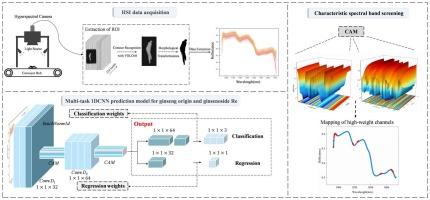利用高光谱成像和多任务一维卷积神经网络同时预测人参产地和人参皂苷Re含量
IF 5.6
2区 工程技术
Q1 ENGINEERING, MULTIDISCIPLINARY
引用次数: 0
摘要
产地溯源和皂苷含量测定是人参质量控制的关键因素,但传统方法需要独立建模,在小样本情况下存在困难。统计分析表明,人参皂苷Re含量具有来源特异性。本研究构建了一个整合频道关注模块的多任务一维卷积神经网络,结合高光谱技术和不确定性驱动的动态加权策略,实现了来源分类和内容预测的同步进行。通过注意权重的可视化分析了波长、来源和皂苷之间的关系。该模型的分类准确率为92.59%,F1得分为0.8969,精密度为0.9125,召回率为0.8857。回归任务的R2为0.9074,RMSE为0.0060,RPD为3.2864。结果表明,与随机森林和支持向量机等经典机器学习模型以及单任务1DCNN相比,该模型对人参产地和人参皂苷Re含量的预测更有效、准确。高权重信道对应于与预测任务高度相关的波长。该方法为人参产地溯源和质量控制提供了一种新的方法,显示了多任务预测的巨大潜力,为中药标准化和产业化奠定了基础。本文章由计算机程序翻译,如有差异,请以英文原文为准。

Simultaneous prediction of Panax ginseng origin and ginsenoside Re content using hyperspectral imaging and a multi-task one-dimensional convolutional neural network
Origin tracing and saponin content determination are key factors in ginseng quality control, but traditional methods require independent modeling and encounter difficulties in small-sample scenarios. Statistical analysis revealed that ginsenoside Re content exhibits origin-specific associations. In this study, a multi-task one-dimensional convolutional neural network integrating channel attention modules was constructed, combined with hyperspectral technology and an uncertainty-driven dynamic weighting strategy, to achieve simultaneous origin classification and content prediction. The relationship between wavelength, origin, and saponins was analyzed through visualization of attention weights. The model achieved a classification accuracy of 92.59%, F1 score of 0.8969, precision of 0.9125, and recall of 0.8857. The regression task yielded an R2 of 0.9074, RMSE of 0.0060, and RPD of 3.2864. Results demonstrate that compared to classical machine learning models such as random forest and support vector machine, as well as single-task 1DCNN, the proposed model exhibits efficient and accurate prediction of ginseng origin and ginsenoside Re content. High-weight channels correspond to wavelengths highly relevant to the prediction tasks. This method provides a novel approach for ginseng origin tracing and quality control, demonstrating the significant potential of multi-task prediction and establishing a foundation for the standardization and industrialization of traditional Chinese medicine.
求助全文
通过发布文献求助,成功后即可免费获取论文全文。
去求助
来源期刊

Measurement
工程技术-工程:综合
CiteScore
10.20
自引率
12.50%
发文量
1589
审稿时长
12.1 months
期刊介绍:
Contributions are invited on novel achievements in all fields of measurement and instrumentation science and technology. Authors are encouraged to submit novel material, whose ultimate goal is an advancement in the state of the art of: measurement and metrology fundamentals, sensors, measurement instruments, measurement and estimation techniques, measurement data processing and fusion algorithms, evaluation procedures and methodologies for plants and industrial processes, performance analysis of systems, processes and algorithms, mathematical models for measurement-oriented purposes, distributed measurement systems in a connected world.
 求助内容:
求助内容: 应助结果提醒方式:
应助结果提醒方式:


